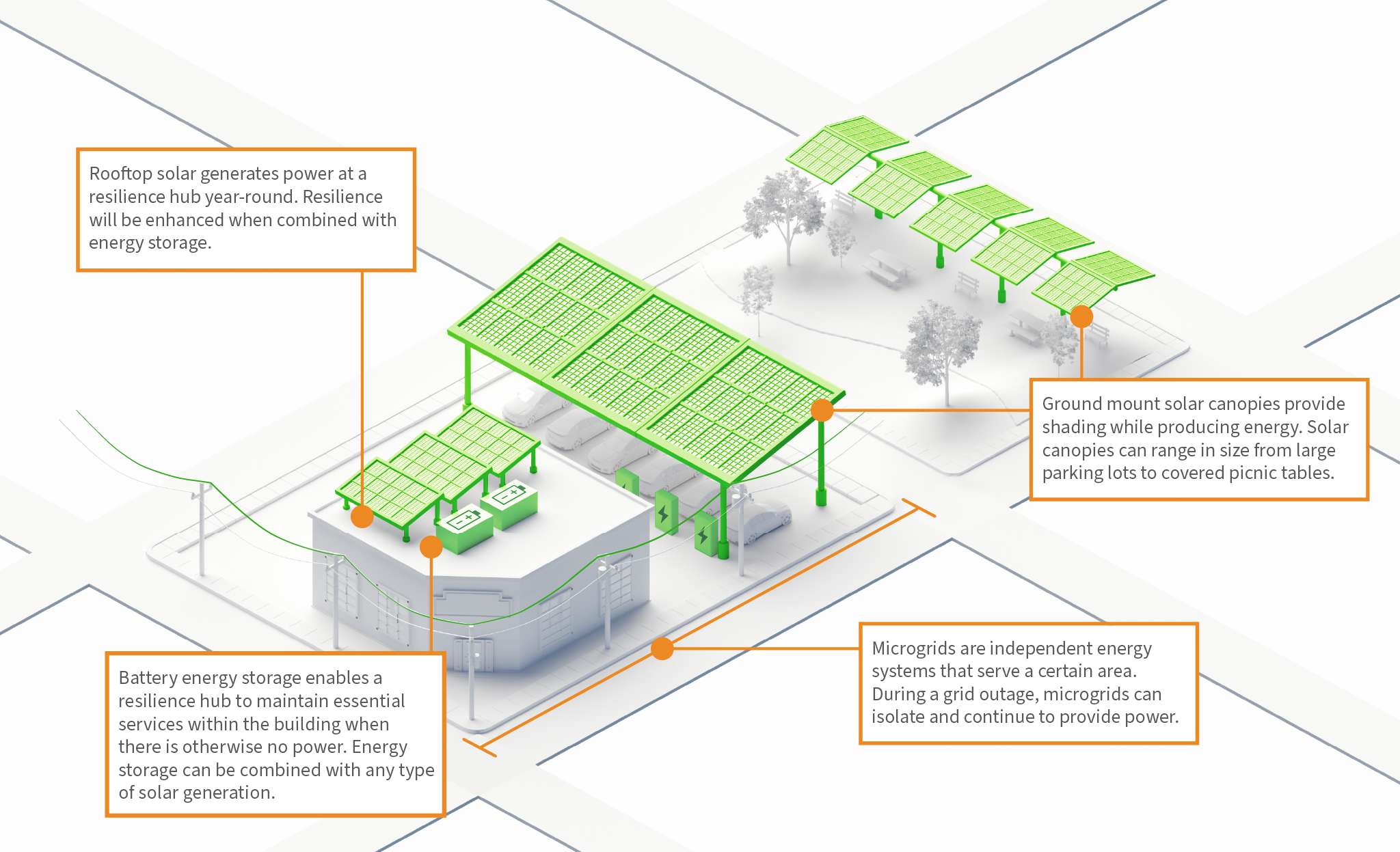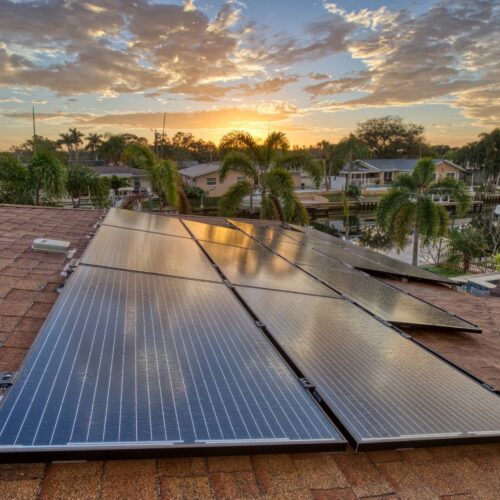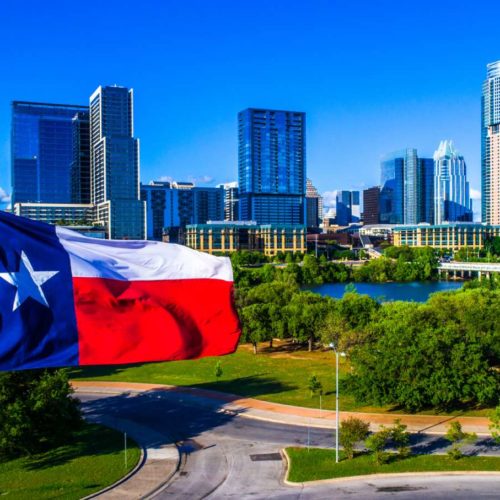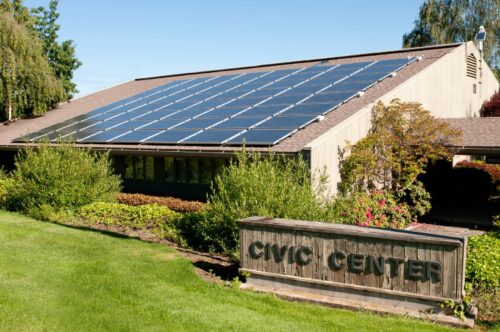
Weathering Climate Disasters with Resilience Hubs
In the face of worsening extreme weather, cities are creating resilience hubs to provide communities with numerous health, economic, and environmental benefits.
As climate-fueled disasters increase in frequency and intensity — taking a heavy toll on human lives, infrastructure, and the power grid — communities are being forced to prioritize resilience. In recent years, Americans have faced devastating extreme cold, record heat waves, rapidly intensifying hurricanes, and an increase in billion-dollar disasters. Since June of 2022, we’ve had nine billion-dollar disasters, with recent disasters, like Hurricane Ian, adding to that list. To confront these extreme conditions, protect vulnerable residents, and enhance community development, dozens of cities across the United States are deploying “resilience hubs.” Below we dive into what resilience hubs are and shares lessons learned from cities that are successfully deploying these hubs.
What Are Resilience Hubs and What Can They Do?
Resilience hubs are physical, community-serving facilities that support residents, distribute needed resources, reduce carbon pollution, and enhance quality of life. Resilience hubs offer local governments a powerful means of supporting vulnerable populations before, during, and after an extreme weather event or other disasters, while simultaneously empowering and shifting resources directly to those communities. Depending on the needs of the communities where hubs are located, they can support resilience across five foundational areas — ensuring reliable power, coordinating communication, providing dependable facilities, managing operations, and offering valuable services and programming. For communities considering resilience hubs, USDN's Resilience Hub website offers a range of resources and guidance to get started.

Illustration of a Resilience Hub in Austin, Texas. In response to Winter Storm Uri, the city of Austin passed a resolution to create resilience hubs. Now, the City of Austin is working with the Austin school district, Travis County, and community partners to pilot six Resilience Hubs in Austin’s Eastern Crescent, with plans to build a future network of Hubs to serve the greater community. Source: City of Austin
Six Key Lessons for Communities Looking to Develop Resilience Hubs
Following Winter Storm Uri, RMI assisted Texas cities in planning for and deploying resilience hubs in their communities. Below we detail the lessons learned from cities that are implementing these hubs to help others incorporate them into their climate change adaptation toolbox.
1. Secure early buy-in from city decision makers and community partners
Resilience hubs are most successful when the city and the community are brought into the project from the beginning. Active participation with key stakeholders helps resilience hubs be sited where they can meet the most community needs and effectively reach vulnerable populations. Clearly communicating the potential of resilience hubs to address multiple city and community goals is an important way to secure support and encourage participation. These hubs can create a range of health, economic, and environmental benefits that can make them attractive to communities facing increasingly severe climate and other disasters.
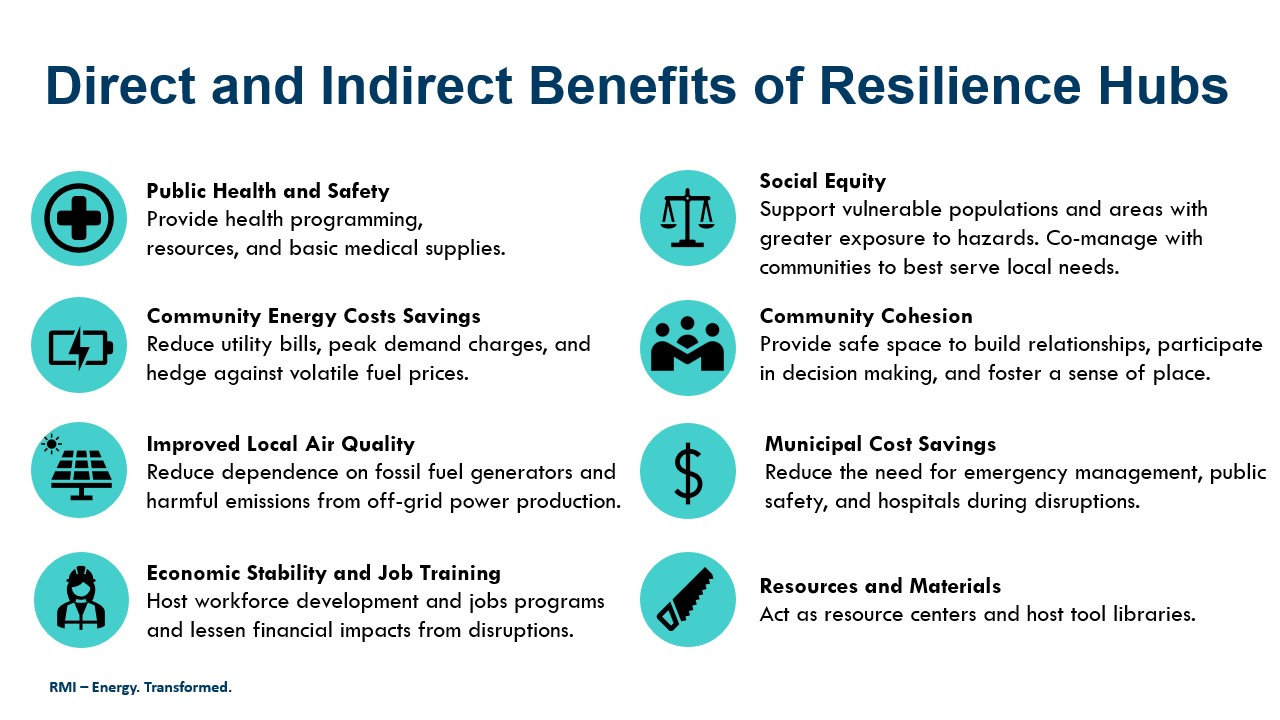
2. Partner with community organizations and local businesses to develop and deploy resilience hubs
Cities can work with community organizations to identify the objectives, potential sites, roles and responsibilities of partners, and services to offer at each resilience hub. For instance, the nonprofit Groundswell is working in West Atlanta with four Historically Black Colleges and Universities to create resilience hubs that support an energy-burdened community while also providing real-world opportunities for students to learn about renewable power. Groundswell led community engagement meetings, attended by the public and city staff, to decide what services to offer through the hub — such as food storage, medicine storage/formula, heating and cooling, and charging — and to help determine what functions need to be powered with solar and storage during a power outage.
3. Carefully consider where to site your resilience hub (city buildings versus community sites)
Resilience hubs will be most successful when sited in a well-used facility that a city’s most vulnerable residents feel comfortable using. While municipal buildings can host resilience hubs, cities should consider whether they can reliably offer 24/7 access to the building. It is also important to ensure that the community feel comfortable using the building — for example, some community members might be more willing to go to a library or community center in an emergency than they would city hall.
In some places, community owned and operated sites may be most effective. For example, Baltimore’s successful Community Resilience Hub program partners with “trusted, service-based non-profit community organizations (including faith-based) with strong leadership located in under-resourced neighborhoods” to host sites. The city supports these resilience hubs by providing training, supplies, and assistance to outfit hubs with solar and battery storage.
4. Start by making your hub energy efficient to enhance resilience and save lives
Enhancing energy efficiency at a resilience hub can increase “hours of safety” — a measurement of how long a building can maintain a safe, comfortable temperature when the power goes out. This can be accomplished with insulation, a tight building envelope, cool or green roofs, and other interventions. Increasing “hours of safety” enables a resilience hub to be a reliable, safe location during a range of disruptions regardless of whether the site has backup power. Starting with energy efficiency will also help optimize the building for future solar and storage installations.
In situations where the electric grid’s stability is threatened, resilience hubs that are efficient and weatherized can be lifesavers. During 2021’s Winter Storm Uri, over two hundred people died, most of them from hypothermia when there was no way to heat their homes. In future events, resilience hubs could provide a safe location for residents to receive critical support and supplies or wait out a storm.
5. Adding solar and storage can provide essential backup power while meeting a range of resilience, environmental, and health goals
Solar and battery storage provide a resilience hub with electricity during power outages. Solar and storage can also reduce utility bills and hedge against volatile fuel prices year-round, as residents, businesses, and cities all experienced during Winter Storm Uri and during recent heat waves in Texas. Not only does this benefit building operators, but it also helps reduce the overall load on the grid providing additional system benefits.
Resilience hubs with solar and storage can be especially impactful for disadvantaged communities. In the case of Storm Uri, low-income communities who did not live on “critical circuits” with hospitals or other critical infrastructure experienced longer power outages — some up to four days — as the limited power available was prioritized elsewhere.
Additionally, in an emergency situation, first responders and hospitals are often the first priority for fuel for their generators. The more effectively hubs can supply their own power without relying on outside fuel or electricity, the better they can serve people during crises.
"The solar power and energy storage on the hubs provides resilience and ensures that our hubs will have consistent power when liquid fuel might be needed to support other emergency services during a disruptive event,” says Ian LaHiff, energy project manager working on the City of Orlando’s resilience hub program.
6. Take advantage of new funding to deploy resilience hubs now
Widely available federal funding makes it easier than ever to fund resilience hubs. The Biden Administration recently allocated $2.3 billion to the Building Resilient Infrastructure and Communities program, which has expanded in focus to help mitigate the dangers of extreme heat. Other programs have been restored, including Congress' Community Project Funding and the Department of Energy's Energy Efficiency Block Grant Program, both of which offer flexible funding to states and local governments bolstering community resilience. The recently passed Inflation Reduction Act also dramatically expands financial incentives for solar and storage projects and includes promising funding for Environmental and Climate Justice Block Grants, which will prioritize urban heat mitigation among other resilience measures.
Additionally, states and utilities are taking their own novel approaches. For example, California, Maryland, and Massachusetts have created grant funding programs for resilience hubs that other states can replicate. Utilities like PG&E in California and Xcel Energy in Minneapolis are funding resilience hubs with backup power to enhance grid resilience and offset the impact of future power outages.
Making Communities Safer
Cities are on the frontlines of many unique challenges in a world with more frequent and severe extreme weather and grid outages. Resilience hubs are one way for cities to tangibly protect all residents with community-focused solutions that support a safer, more sustainable, and more connected future. With these lessons and new federal funding opportunities, communities can proactively plan and deploy resilience hubs to protect their communities before the next disaster strikes.
